| | thepotteries.org |
| Asiatic
Pheasants
"With the exception of the standard Willow pattern this was probably the most popular of all blue-printed designs in the second half of the 19th century, and even into Edwardian times. It was usually marked with a floral scroll, often with the maker's initials. The pattern was printed in a pale blue and shows a pheasant or pheasants, amongst flowers and foliage within an undistinguished floral border." from: Coysh and Henrywood - Dictionary of Blue & White Printed Pottery 1780-1880. |
| Ralph Hall
Ralph Hall of the Swan Bank works, Tunstall was the original manufacturer of the Asiatic Pheasants pattern, which he produced in blue, black and brown. Hall originally operated with his brother John but from 1822 they separated and Ralph continued on his own account at the Swan Bank works. His business was heavily involved in the North American market and Ralph Hall was responsible for the production of two major series of blue transfer ware patterns:- the Select Views Series and the Picturesque Scenery Series. For many years it was thought that Podmore & Walker were the original manufacturers of Asiatic Pheasants - this was largely based on a backstamp introduced by Wedgwood & Co (sucessors of Podmore & Walker) which claimed 'The original manufacturers' There are a number of items of ware with the mark of Ralph Hall that show that he was also producing the Asiatic Pheasants pattern.
|
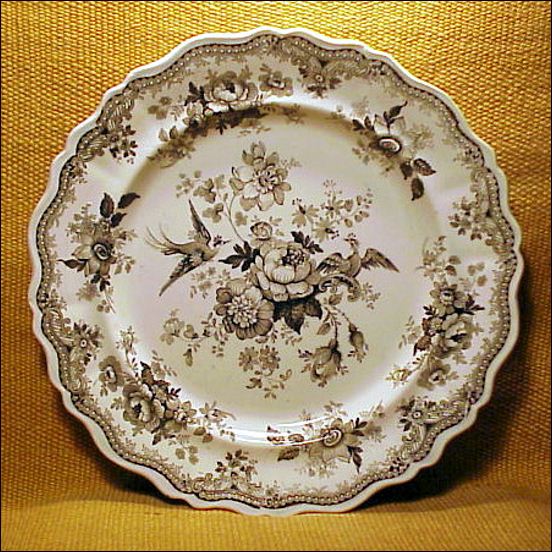 brown transfer-ware in the original Asiatic Pheasants pattern by Ralph Hall |
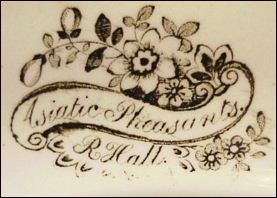 Asiatic Pheasants R Hall |
photos: Seeker Antiques
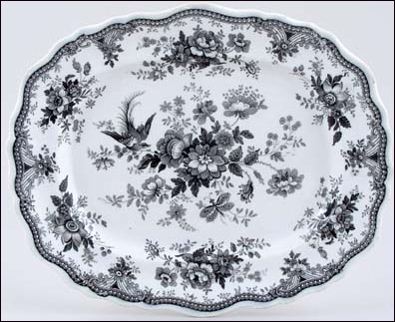 Backstamp: HALL impressed with 9 below and black printed typical floral cartouche with Asiatic Pheasants in a ribbon and R Hall beneath. |
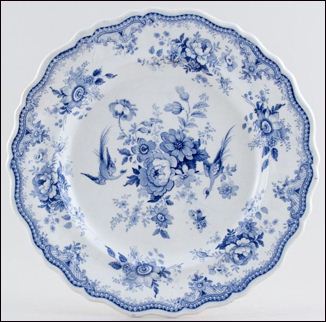 Backstamp: blue printed typical floral cartouche with Asiatic Pheasants in a ribbon and R Hall beneath. |
photos: Lovers of Blue & White
| Podmore, Walker &
Co Podmore, Walker & Co operated in Tunstall from 1834 to 1859 from five potteries at various times. Around 1835 Enoch Wedgwood (a distant cousin of Josiah Wedgwood) became a partner - he was the '& Co' When Ralph Hall ceased trading around 1849 his Swan Bank works was taken over by Podmore & Walker around 1853. Podmore Walker and Co had established strong export links, particularly in North America, with a series innovative contemporary romantic patterns and is thought that there was some relationship between Hall and Podmore & Walker, particularly in the North American Trade. Podmore & Walker never claimed to be the original manufacturers of Asiatic Pheasants, however a backstamp introduced by Wedgwood & Co (sucessors of Podmore & Walker) stated 'The Original Manufacturers' - some sources say that Ralph Hall produced the pattern earlier - it is thought from around 1830. This would make him the original manufacturer, however as there was an overlap of the manufacturing dates of the two companies it could be that Podmore & Walker were the original manufacturers and allowed Ralph Hall to manufacture it as well. |
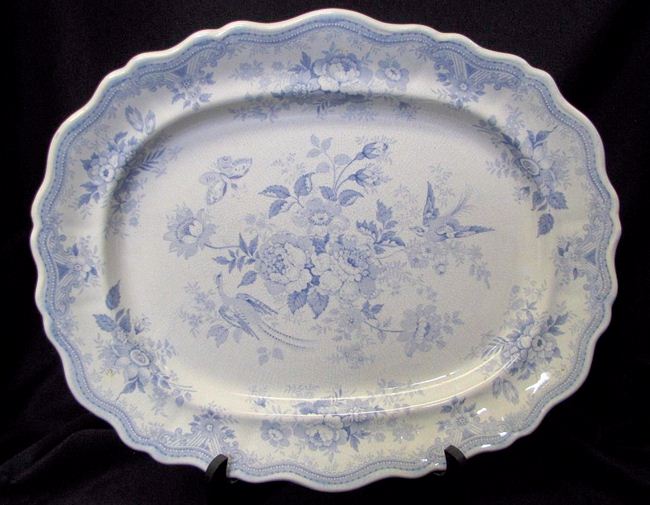 large platter in the Asiatic Pheasants pattern by Podmore & Walker |
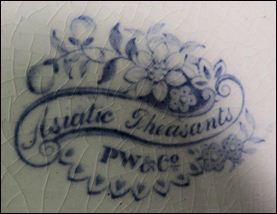 Asiatic Pheasants P W & Co |
| Wedgood & Co (&
successors) Enoch Wedgwood (a distant cousin of Josiah Wedgwood) became a partner in Podmore, Walker & Co. in 1835 and in 1856 the business was renamed Podmore, Walker, Wedgwood & Co. The company continued to make the popular Asiatic Pheasants pattern. At sometime prior to 1900 (when the business became a Limited Company) the words 'The Original Manufacturers' were added to the Asiatic Pheasants scroll mark. In actual fact the pattern was produced prior to the establishment of Wedgwood & Co in 1860, by Podmore & Walker and Ralph Hall. Around 1925 the wording 'Estabd 1835' was added to some of the Wedgwood & Co marks - this was a marketing gimmick as Wedgwood & Co started in 1860. The date 1835 was when Enoch Wedgood joined Podmore and Walker - Wedgwood was the '& Co'. |
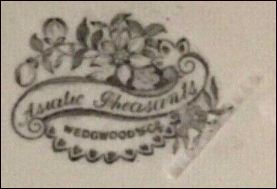 Asiatic Pheasants Wedgwood & Co c.1860-1900
|
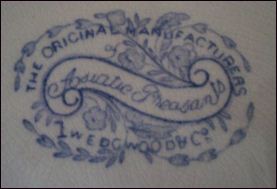 The Original Manufacturers Asiatic Pheasants Wedgwood & Co At sometime prior to 1900 (when the business became a Limited Company) the words 'The Original Manufacturers' were added to the Asiatic Pheasants scroll mark. In actual fact the pattern was produced prior to the establishment of Wedgwood & Co in 1860, by Podmore & Walker and also by Ralph Hall. |
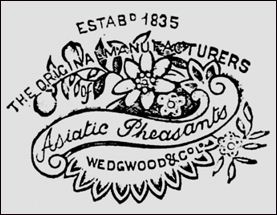 Estabd 1835 The Original Manufacturers Asiatic Pheasants Wedgwood & Co Ld c.1925+ Wedgwood & Co was established in 1860 - it was around 1835 that Enoch Wedgwood joined with the former company of Podmore & Walker. |
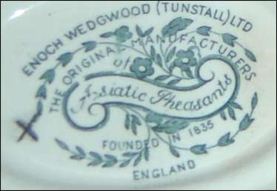
Enoch Wedgwood (Tunstall) Ltd. In 1965 the company Wedgwood & Co. was sold to Semart Importing Co. based in New Jersey, USA and refloated as Enoch Wedgwood (Tunstall) Ltd. They continued to use 'Original Manufacturers' and 'founded in 1835' 1965-1980 |
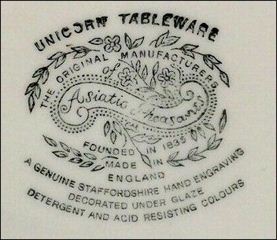 Unicorn Tableware In 1980 Josiah Wedgwood & Sons Ltd (who, up to this point had nothing to do with Wedgwood & Co.) purchased Enoch Wedgwood and it operated within the Wedgwood Group as the 'Unicorn Pottery'. 1980+ |
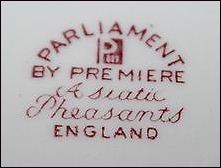
this company made Asiatic Pheasants and used 'Original Manufacturers' and 'founded in 1835' in some of their marks [reported to be 1980-2002] - no details are known about this company - |
| Other manufacturers of
Asiatic Pheasants
There is some uncertainty in identifying the originator of the pattern, it was either Ralph Hall of the Swan Bank Pottery in the town of Tunstall (1822 to 1849), or Podmore, Walker & Co also based in Tunstall (who started manufacturing in 1834) who claimed to be the original manufacturers.
Co-operation between pottery firms was not uncommon, patterns were known to be loaned and when large orders came in they were frequently sub-contracted to firms with spare capacity, even competitors to meet the demand. |
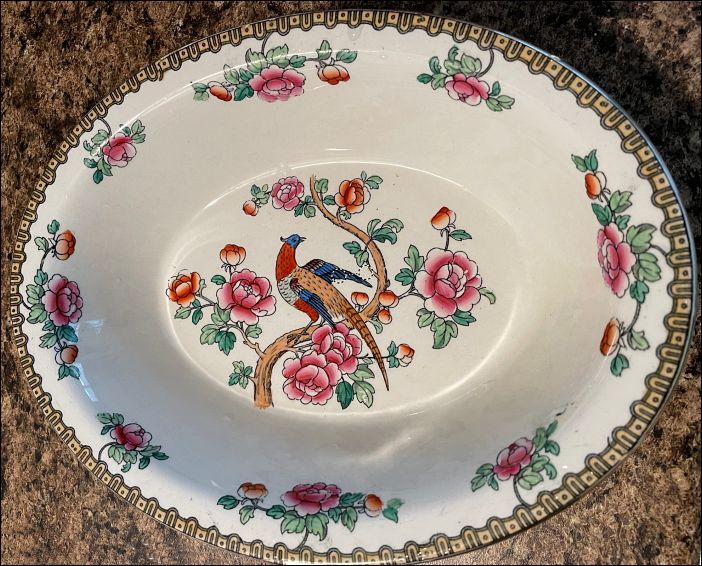
dish in the PHEASANT
pattern - printed outline and hand coloured
this pattern by F. Winkle was based on the very popular blue & white Asiatic Pheasants pattern
photo courtesy: Kathy Rae